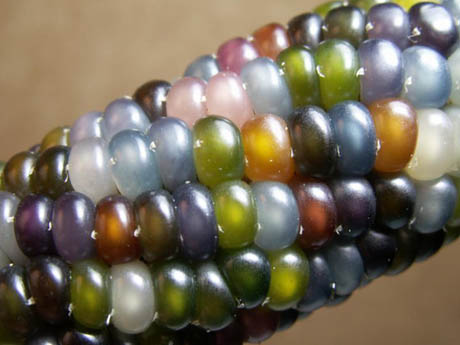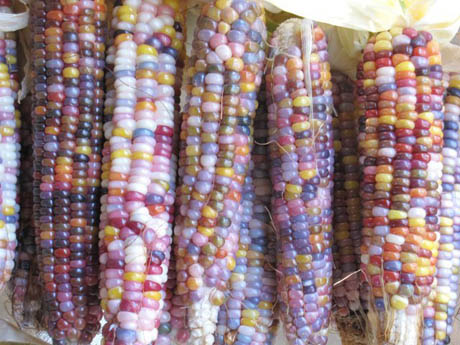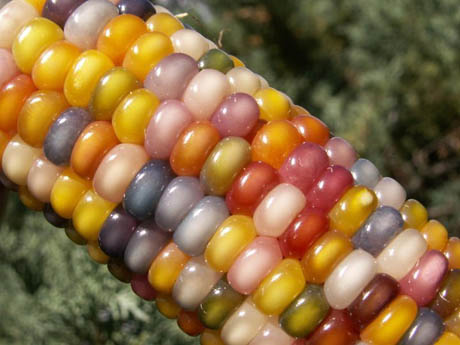
IMAGE: Glass gem corn, via the Seeds Trust Facebook page.
This photograph of an ear of glass gem corn has been making the rounds on the internet over the past week (often accompanied with a note declaring it is NOT PHOTOSHOPPED!).
What happened is that, last year, seedsman Greg Schoen was moving and left some of his corn varieties, most of which originally came from part-Cherokee “corn-teacher” Carl Barnes, with his fellow seed-saving enthusiast and Seeds Trust founder Bill McDorman. Bill grew some, and “got so excited, [he] posted a picture on Facebook.”

IMAGE: Glass gem corn, via the Seeds Trust Facebook page.
The result, writes Bill, is that “GLASS GEM corn has gone viral!” There is no more seed for sale this season, and the Seeds Trust website keeps going down under the pressure of the world’s newfound interest in this corn varietal.
As it happens, before human selection interfered, corn ears were all multi-coloured.* Kernels are siblings housed on the same ear, meaning that each kernel has its own set of genes, including those that control colour. According to the Toronto Globe and Mail columnist April Holladay:
Livestock feeders prefer vitamin-rich yellow kernels, Southerners like white kernels, and Native Americans favor blue. Years of deliberate selection, careful pollination, and storing of seeds produced these single-color corn ears. […] Some studies suggest corn pigments promote resistance to insects or fungi that invade an ear of corn.

IMAGE: Glass gem corn, via the Seeds Trust Facebook page.
Before you rush to add your name to the waiting list for glass gem seeds, I should just add that this kind of flint corn is usually nixtamalised and ground into flour for tortillas, hominy, polenta, and tamales, which (as Rachel Laudan convincingly demonstrated at Postopolis DF!) is a rather exhausting and time-consuming process.
Still, it is the most beautiful corn in the world.
[NOTE: I came across glass gem corn via that long-time Edible Geography standby, the Agricultural Biodiversity Weblog.]
[UPDATE: *In response to a charming comment via Twitter, I should add that the evolution of corn from teosinte is actually a long and rather complicated story, but that selective breeding certainly encouraged the development of single-colour ears.]
14 Comments
I am a Kindergarten teacher, and I would love to just have the children make things with it. But it looks like it is a highly prized possession.
This is the most beautiful corn in the world. My wife and I started a crop of 40 seeds and all 40 germinated. As of now, we have a total of about 30,000 seeds for sale. We have so many varieties that it makes sense about each kernel having its own set of genes. We used pure mushroom compost as our soil and the results were phenomenal. We are excited to be a part of this fairly new following. If anyone is interested in getting some seeds, please email me at salteejoes@gmail.com. Anyone know of any other uses other than ornamental?
I have plenty of seed and the colors are amazing you can contact me if your looking for seed. The seed that I planted was very small, but the seed I have to plant and sell are much larger. I had some stalks get almost 13 feet tall since the seed was grown in it’s native soil of Oklahoma. I used liquid fish to get it up and going with wood ash to set the bloom. All organic and no pesticides were ever used at anytime. Oddly there were a couple of the tassels that put corn on the top and I had never seen anything like it!
I believe that this cornis best suited for ………ME! It’s just beautiful…..Can’t wait until I can get some!
Actually, flint corn is better used for polenta and grits, and softer flour and dent corns are better suited to nixtamalization for tortillas and hominy. Flint corn is very, very hard, and is difficult to grind. But it makes a fine polenta. So you could simply dry this corn very well, then grind it and boil it for several hours for a wonderful meal.
Now, there’s a business model to see about – multi-colored gem candy corn. Translucent, multi-colored sugary kernels. If you used vegetable colors and raw sugar you could market it to the all-natural vegan crowds too.
As an artist, I am always amazed at how Nature does beauty so easily. You know the old saying: “Wish I had thought of that.”
Thanks, Anna and Ben!
Nicola that’s so cool you got linked by Michael Pollan!
Congrats on being Michael Pollan’s “Daily Link”! http://michaelpollan.com/todays-link/
Biodiversity is beautiful
You should be aware that Bill McDorman is now the executive director of Native Seeds/SEARCH. Glass gem corn is currently being conserved in the NS/S seed bank, grown at their conservation farm, and available directly from them on the web: nativeseeds.org.
Nice take on the story. I’m betting, though, that a tortilla made from this corn would end up about as appealing in colour as the Plasticine I used to play with as a small child.
I love that word “nixtamalised.”
Beautiful corn, too. I wish someone would make it so it tastes like candy.
Mike